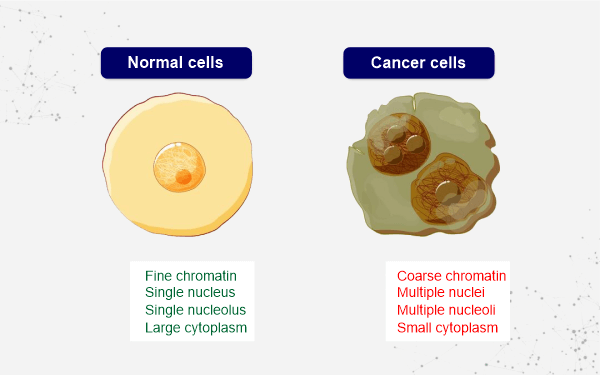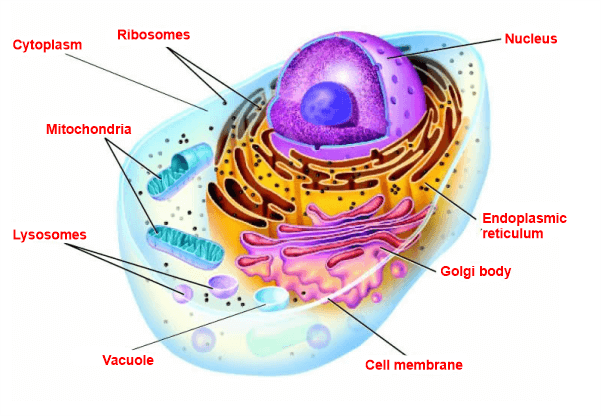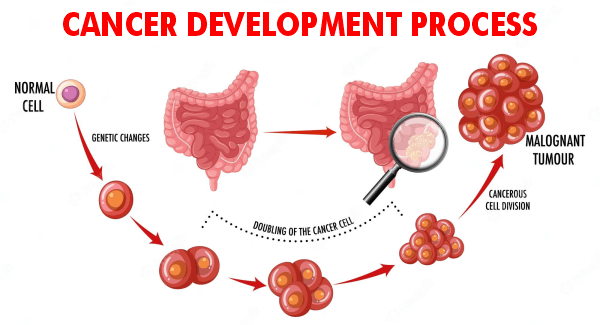Difference between Normal Cell and Cancer CellThe fundamental building block of life, called cells, perform a variety of tasks for the body. They are incredibly intricate structures capable of performing a wide range of vital life-supporting functions. In the context of cells, the two common terms we hear most often include normal cells and cancer cells. While cancer cells are characterized by uncontrolled proliferation and division that results in the formation of tumors, normal cells are distinguished by a definite purpose and lifespan. The fundamental units of all living things are cells. It should be noted that there are important differences between normal cells and cancer cells, which we will be exploring in this article. 
What are Normal Cells?A normal cell is a basic structural and functional unit of life. It is a small, microscopic entity capable of performing various functions within the human body. Understanding a cell's normal structure and function is essential for understanding how the body works and how diseases develop. Here are some key points about normal cells: The Components of a Normal Cell
Cell Membrane: The cell membrane is a thin layer of lipid and protein molecules that surround the cell. It acts as a barrier between the cell and its environment and controls the movement of substances in and out of the cell. The cell membrane is selectively permeable, which means that it only allows certain molecules to pass through it. Cytoplasm: The gel-like material that engulfs the cell is called cytoplasm. It consists of water, salts, enzymes, and various organic molecules. The cytoplasm contains various organelles, such as the endoplasmic reticulum, Golgi apparatus, mitochondria, lysosomes, and ribosomes, which are involved in various cellular processes. Nucleus: The nucleus is a membrane-bound organelle that contains the cell's genetic material in the form of DNA. It is responsible for controlling the cell's growth and reproduction. The nucleus is surrounded by a nuclear envelope that contains pores, which allow molecules to move in and out of the nucleus. Mitochondria: Mitochondria are organelles that are responsible for producing energy for the cell. They are often referred to as the cell's powerhouse. Mitochondria are found in large numbers in cells that require a lot of energy, such as muscle cells. Endoplasmic Reticulum: The endoplasmic reticulum (ER) is a network of flattened sacs and tubules that are involved in protein synthesis, lipid metabolism, and detoxification. There are two types of ER, such as rough ER and smooth ER. The rough ER has ribosomes attached to its surface, which are involved in protein synthesis. The smooth ER lacks ribosomes and is involved in lipid metabolism and detoxification. Golgi Apparatus: The processing and classification of proteins and lipids produced in the ER take place in the Golgi apparatus, which is a pile of flattened membranes. These molecules are also altered by the Golgi apparatus, which then places them in vesicles for transportation to different areas of the cell or for release outside the cell. Lysosomes: Cellular trash and foreign substances are broken down and recycled by enzymes found in lysosomes, which are a type of organelles. Lysosomes are involved in the destruction of pathogens that enter the cell and in the breakdown of damaged organelles. Ribosomes: Small organelles called ribosomes are important in the production of proteins. Either they are observed adhering to the surface of the ER or moving freely in the cytoplasm. Ribosomes read the genetic code in the form of messenger RNA (mRNA) and synthesize proteins by linking amino acids together in a specific sequence. Nucleolus: The production of ribosomal RNA (rRNA) and the assembling of ribosomes takes place in the nucleolus, which is a tiny structure inside the nucleus. The nucleolus contains DNA, RNA, and proteins. Structure of a Normal CellA normal cell has three main parts: the cell membrane, the cytoplasm, and the nucleus. A thin, pliable covering called the cell membrane surrounds the cell and serves as a barrier, enabling some substances to enter and leave the cell. The cytoplasm is a gel-like substance that fills the cell and contains various organelles, including mitochondria, ribosomes, and the endoplasmic reticulum. The genetic material (DNA) and the command center of all the cells are both located in the nucleus. The function of a Normal CellProducing Energy: Mitochondria are responsible for producing energy in the form of ATP through a process called cellular respiration. Synthesizing Proteins: Ribosomes are responsible for synthesizing proteins using the information stored in DNA. Transporting Substances: The endoplasmic reticulum and Golgi apparatus are responsible for transporting and modifying proteins and lipids. Maintaining Cell Structure: The cytoskeleton is responsible for maintaining the structure of the cell and facilitating cell movement. Cell Division: The nucleus and various organelles work together to ensure proper cell division. Types of Normal CellsThe human body has several types of normal cells, each with its own structure and function. Some examples include:
Cell CycleThe cell cycle is the process by which a cell divides and creates new cells. Various checkpoints regulate it and involve several phases, including interphase (G1, S, and G2) and mitosis. Proper cell cycle regulation is essential for normal cell growth and division. Importance of Normal CellsUnderstanding the normal structure and function of cells is essential for understanding how the body works and how diseases develop. By studying normal cells, researchers can identify abnormal cells and develop new treatments for diseases such as cancer. Understanding normal cells can also help us develop new technologies, such as stem cell therapy, that can help treat a variety of conditions. What are Cancer Cells?Cancer is a term used to describe a group of diseases that are characterized by the uncontrolled growth and spread of abnormal cells. These abnormal cells are commonly known as cancer cells. Cancer cells differ from normal cells in several ways, including their appearance, behavior, and function. 
Definition of Cancer CellsCancer cells are cells that have undergone genetic changes that allow them to grow and divide uncontrollably. Contrary to normal cells, cancer cells do not acquiesce to signals that control cell growth and division. As a result, cancer cells continue to grow and divide, forming tumors or invading other tissues. How do Cancer Cells develop?Cancer cells develop when normal cells undergo genetic mutations that alter their behavior. Many things, like exposure to chemicals, radiation, or viruses, can result in such deadly mutations. In some cases, genetic mutations can be inherited from a parent. Characteristics of Cancer CellsCancer cells differ from normal cells in several ways. Some of the key characteristics of cancer cells include:
Types of Cancer CellsThere are many different types of cancer cells, each with its own unique characteristics and behaviors. Some of the most common types of cancer cells include:
How do Cancer Cells spread?With the help of a process called metastasis, cancer cells are able to migrate to different areas of the body. Cancer cells separate from the primary tumor during metastasis and move through the bloodstream or lymphatic system to various body locations. They can continue to grow and divide once they have moved to a new area, creating additional tumors. Treatment of Cancer CellsThe type and stage of cancer, as well as the patient's general condition, all influence how cancer cells are treated. Some of the most common treatments for cancer cells include:
How do Cancer Cells affect the body?Cancer cells can have a profound impact on the body. As they grow and divide, they can destroy normal tissues and organs, causing a range of symptoms and complications. Some of the most common effects of cancer cells on the body include:
Difference between Normal Cell and Cancer Cell
ConclusionIn conclusion, the differences between normal cells and cancer cells are numerous and complex. While normal cells function in a tightly regulated and controlled manner, cancer cells have lost this regulation and grow uncontrollably. Cancer cells have a disrupted DNA replication and repair process, an altered metabolism, and an ability to evade the body's immune system. These differences are what makes cancer cells dangerous and difficult to treat. Understanding these differences is essential in the development of new therapies and treatments for cancer.
Next TopicDifference between
|
 For Videos Join Our Youtube Channel: Join Now
For Videos Join Our Youtube Channel: Join Now
Feedback
- Send your Feedback to [email protected]
Help Others, Please Share










